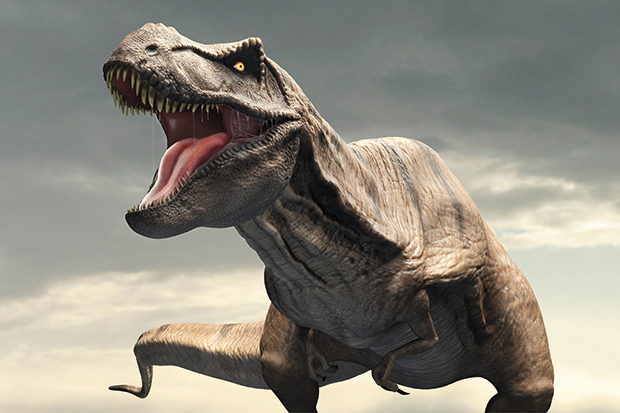Tyrannosaurus rex is the greatest celebrity of all time. The 68–66 million-year-old carnivore is far older than any actor or musician, including Keith Richards, and yet is still must-have talent for Hollywood blockbusters, comics, museum displays and more. But all that fame comes at a cost. There seems to be as much mythology as science surrounding the ‘tyrant lizard king’. The paleontologist David Hone seeks to slice through fiction and chew over fact in his new book The Tyrannosaur Chronicles.
From the title, you can be forgiven for thinking that this is the journal of an angsty T. rex. Rather, Hone has written a handbook to almost everything you’d want to know about the celebrated dinosaur and its various kin. Early on, he points out that when he wrote the book there were 29 recognised tyrannosaur species spanning about 165 million years — with the recently named timurlengia bringing the total to an even 30. T. rex and other late Cretaceous giants get all the love, but the very first tyrants didn’t really deserve the title at all: they were small saurians no more than two metres long, with long arms, thin snouts, and covered in downy fuzz. Tyrannosaurs stayed this way for tens of millions of years, only becoming Jurassic Park’s giants in the last 20 million years of their reign.
All of these additional tyrants get some space — creatures such as lythronax, nanuqsaurus and oianzhousaurus so new that they’ll likely be unfamiliar to most readers — but even they are overshadowed by the mighty T. rex. As Hone himself acknowledges, that’s because T. rex is undoubtedly the most studied prehistoric creature of all time: there’s simply more to say about it because more research has been conducted on it. The dinosaur is as beloved by scientists as by the public, and so almost every idea or study generates more debate.
Take its food, for example. There’s a widespread impression that T. rex was nothing but a filthy scavenger, lazily horfing down carrion instead of hunting for itself. This idea did not come from any fossil find or study, however; it was popularised by the paleontologist Jack Horner in the 1990s as a way to kick the fossil hornets’ nest and get his colleagues to test assumptions about the tyrannosaur’s predatory abilities. Thanks to Horner’s authority, and basic cable television documentaries popularising the idea, though, the image of scavenging T. rex had legs, and so Hone goes into detail in hopes of dispatching the myth once and for all. The anatomy of the dinosaur, healed bite wounds on other dinosaurs, and what we know about prehistoric ecology all underscore the fact that T. rex hunted live prey but wouldn’t pass up a free meal if it sniffed one out.
The Tyrannosaur Chronicles will do more than update readers on the nitty gritty of T. rex and its kin, though. In due course Hone covers the way dinosaur species are named, how their relationships to each other get sorted, what we know of dinosaur ecology, the mechanics of evolution, and more. T. rex is the star attraction here, but Hone continues to put the dinosaur through its paces as an ambassador for paleontology and what we know about dinosaurs. What was true for T. rex was also true of many other dinosaurs, and so, by trailing T. rex, Hone also delivers an updated view of the ‘terrible lizards’ as a whole.
If there’s any drawback, it’s that the book exists in a strange place between popular science narrative and textbook. Every page is packed with dinosaurian information, but Hone’s writing style is a little dry. Diehard dinosaur fans won’t mind this, but casual readers may have a more difficult time plodding through the basics of dinosaur anatomy and systematics. The book, contrary to the title, is not so much The Tyrannosaur Chronicles as a Tyrannosaur compendium.
Nevertheless, in a single book Hone has been able to offer an up-to-date and exhaustive look at almost everyone’s favourite dinosaur. What emerges is not T. rex the movie star or T. rex the monster, but a living, breathing animal that we are really just beginning to understand. This was a carnivore that walked, slept, pooped, mated and, yes, ate, and new finds are allowing us to envision all those processes with greater clarity than ever before. The animals themselves are long dead, but through science and imagination the tyrannosaurs will continue to sink their teeth into our minds.
Got something to add? Join the discussion and comment below.
Get 10 issues for just $10
Subscribe to The Spectator Australia today for the next 10 magazine issues, plus full online access, for just $10.
Available from the Spectator Bookshop, £13.99. Tel: 08430 600033. Brian Switek blogs about palaeontology for Scientific American and is the author, among other books, of My Beloved Brontosaurus.
You might disagree with half of it, but you’ll enjoy reading all of it. Try your first month for free, then just $2 a week for the remainder of your first year.














Comments
Don't miss out
Join the conversation with other Spectator Australia readers. Subscribe to leave a comment.
SUBSCRIBEAlready a subscriber? Log in